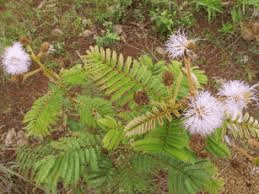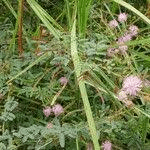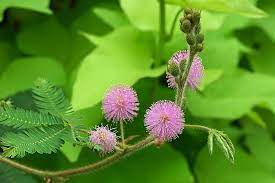18 Medicinal Health Benefits Of Mimosa somnians (Dormideira)
Mimosa somnians, commonly known as Dormideira, is a fascinating plant species renowned for its unique characteristics and intriguing behavior. This perennial herb belongs to the Fabaceae family and is native to various regions of South America, including Brazil and Argentina.
The most distinctive feature of Mimosa somnians is its responsive foliage, which exhibits a remarkable sensitivity to touch. The compound leaves of the Dormideira are bipinnate, consisting of numerous small leaflets. What sets this plant apart is its rapid leaf-folding response to external stimuli.
Upon physical contact or disturbance, the leaflets quickly fold together, creating a spectacular display of movement. This mechanism is an adaptive response to potential threats, as the sudden folding may deter herbivores or insects.
The plant’s scientific name, Mimosa somnians, hints at another intriguing aspect of its behavior. The term “somnians” refers to its ability to exhibit sleep-like behavior during the night.
The leaves of Dormideira tend to close in the evening and reopen in the morning, reminiscent of the daily cycle of sleep and wakefulness observed in animals.
Beyond its captivating movements, Mimosa somnians has been traditionally used in herbal medicine by indigenous communities. Extracts from various parts of the plant are believed to possess medicinal properties, although scientific studies are ongoing to validate these claims.
Cultivating Dormideira can be a rewarding experience for plant enthusiasts and botanists alike. Providing well-drained soil and a sunny environment is crucial for its optimal growth.
Mimosa somnians serves as a testament to the marvels of nature, showcasing both its defensive strategies and rhythmic biological processes, making it a captivating subject for botanical enthusiasts and researchers interested in plant behavior.
The Botanical Description of Mimosa somnians
1. Leaf Structure: Mimosa somnians is characterized by bipinnately compound leaves, featuring numerous small leaflets on each pinna, creating a delicate and fern-like appearance.
2. Growth Habit: This medicinal plant exhibits a prostrate or semi-erect growth habit, forming low mats or spreading clusters with its fine branches.
3. Flower Characteristics: Mimosa somnians produces spherical pink to lavender flower heads, creating a visually striking display. The flowers are composed of numerous tiny individual florets.
4. Stem Description: The stems of Mimosa somnians are slender and flexible, often covered with fine hairs. The plant is known for its sensitivity, with leaves folding upon touch or environmental stimuli.
5. Root System: Mimosa somnians typically develops a fibrous and shallow root system, allowing it to adapt to various soil conditions.
6. Aromatic Qualities: The plant emits a mild, earthy aroma, contributing to its sensory appeal. This aromatic quality may play a role in traditional uses.
7. Height and Spread: Mimosa somnians generally grows to a modest height of about 30 to 60 centimeters, forming a sprawling and low-growing canopy.
8. Bark Texture: The bark of Mimosa somnians is smooth and may vary in color, often displaying shades of green or brown.
9. Reproductive Organs: The plant produces small pods containing seeds as part of its reproductive cycle, contributing to its ability to spread and colonize.
10. Seasonal Changes: Mimosa somnians undergoes seasonal changes, with the leaves folding or drooping in response to changes in light or touch.
11. Environmental Preferences: Thriving in well-drained soils and preferring full sunlight, Mimosa somnians is well-adapted to a variety of ecosystems.
12. Unique Characteristics: Mimosa somnians is notable for its unique characteristic of leaf-folding, a phenomenon known as thigmonasty, which is a response to tactile stimulation or changes in the environment.
The Geographic Distribution of Mimosa somnians

1. Native Regions: Mimosa somnians is native to regions of South America, including parts of Brazil, Argentina, and Paraguay.
2. Altitude Range: The plant is commonly found at lower to moderate altitudes, ranging from sea level to elevations of around 1500 meters.
3. Tropical and Subtropical Zones: Thriving in tropical and subtropical climates, Mimosa somnians is often encountered in areas with warm temperatures and distinct wet and dry seasons.
4. Soil Preferences: The plant demonstrates adaptability to various soil types, including sandy, loamy, and clayey soils, as long as they are well-drained.
5. Biotic Associations: Mimosa somnians may form associations with nitrogen-fixing bacteria, contributing to soil fertility in its native habitats.
6. Endemism: While widespread, Mimosa somnians may exhibit localized endemism in certain regions, emphasizing its role in local biodiversity.
7. Ecological Niche: The plant occupies a specific ecological niche, often thriving in disturbed areas, open grasslands, and along roadsides.
8. Human Cultivation: Due to its adaptability, Mimosa somnians is sometimes cultivated for its ornamental value and potential medicinal uses.
9. Conservation Status: Understanding the geographic distribution is crucial for assessing the conservation status, particularly in regions facing habitat loss or degradation.
10. Global Adaptation: Beyond its native range, Mimosa somnians has been introduced and cultivated in other parts of the world, showcasing its adaptability.
11. Migration Patterns: Observing any migration patterns within its native range helps understand the dynamics of its presence in specific areas.
The Chemical Composition of Mimosa somnians
1. Alkaloids: Mimosa somnians contains alkaloids, including mimosine, which may contribute to its pharmacological properties.
2. Flavonoids: Rich in flavonoids, the plant possesses compounds known for their antioxidant and anti-inflammatory effects.
3. Tannins: Tannins, with their astringent properties, are identified in Mimosa somnians, contributing to its diverse chemical profile.
4. Glycosides: The presence of glycosides adds to the chemical composition, potentially influencing the plant’s medicinal uses.
5. Phenolic Compounds: Mimosa somnians contains phenolic compounds, known for their antioxidant and anti-inflammatory properties.
6. Terpenes: Terpenes, including essential oils, contribute to the aromatic qualities of the plant and may have therapeutic effects.
7. Saponins: Mimosa somnians is known to contain saponins, which have foaming and emulsifying properties, potentially impacting traditional uses.
8. Carbohydrates: The plant’s chemical composition includes carbohydrates, providing a source of energy and nutritional value.
9. Proteins: Mimosa somnians may contain proteins, contributing to its nutritional profile.
10. Minerals: Essential minerals such as potassium, calcium, and magnesium are part of the chemical composition, supporting overall health.
11. Lipids: Lipids, including fatty acids, may be present in Mimosa somnians, adding to its nutritional content.
12. Vitamins: The plant may contain vitamins such as vitamin C, further enhancing its nutritional value.
13. Anthocyanins: Some varieties of Mimosa somnians may contain anthocyanins, contributing to potential health benefits.
14. Amino Acids: The presence of amino acids adds to the plant’s nutritional profile, supporting various physiological functions.
Read Also: Rice Tungro Disease: Description, Damages Caused, Control and Preventive Measures
The Medicinal Health Benefits Of Mimosa somnians (Dormideira)

1. Anti-inflammatory Effects: Mimosa somnians has demonstrated anti-inflammatory properties, attributed to compounds like flavonoids and tannins, which may be beneficial for conditions involving inflammation.
2. Antioxidant Support: The flavonoids and phenolic compounds present in Mimosa somnians contribute to antioxidant support, helping the body combat oxidative stress.
3. Wound Healing: Traditional uses of Mimosa somnians suggest its potential in promoting wound healing, possibly due to its antimicrobial and anti-inflammatory properties.
4. Respiratory Health: Compounds in the plant may have a soothing effect on the respiratory system, making it a potential remedy for respiratory issues.
5. Antimicrobial Activity: Mimosa somnians has been associated with antimicrobial properties, suggesting its use in combating infections.
6. Skin Conditions: Topical applications of Mimosa somnians may aid in addressing certain skin conditions, potentially due to its anti-inflammatory and healing properties.
7. Gastrointestinal Health: Traditional uses include addressing gastrointestinal issues, with potential benefits for digestion and gut health.
8. Stress Reduction: The plant’s aromatic qualities may contribute to stress reduction and relaxation, making it valuable in aromatherapy.
9. Immune System Support: Some compounds in Mimosa somnians may have immunomodulatory effects, supporting a balanced immune system.
10. Analgesic Properties: The plant may exhibit analgesic effects, providing relief from pain and discomfort.
11. Anti-anxiety Effects: Preliminary studies suggest that Mimosa somnians may have anti-anxiety effects, potentially influencing mood.
12. Antispasmodic Action: Traditional uses include its antispasmodic properties, making it a remedy for conditions involving muscle spasms.
13. Cardiovascular Support: Certain compounds, such as flavonoids, may contribute to cardiovascular health, supporting heart function.
14. Diuretic Effects: Mimosa somnians may have diuretic effects, aiding in the elimination of excess fluids from the body.
15. Antipyretic Properties: Traditional uses suggest potential antipyretic properties, indicating a role in reducing fever.
16. Anti-allergic Effects: Some compounds in Mimosa somnians may exhibit anti-allergic effects, potentially beneficial for individuals with allergies.
17. Cognitive Benefits: Preliminary studies hint at cognitive benefits, including potential effects on memory and cognitive function.
18. Menstrual Health: Traditional uses include addressing menstrual discomfort, suggesting a role in women’s health.
The Methods of Usage to Achieve the Provided Health Benefits Of Mimosa somnians (Dormideira)
1. Herbal Infusions: Prepare herbal infusions using dried Mimosa somnians leaves to harness its medicinal properties for internal consumption.
2. Topical Applications: Create ointments or poultices with crushed Mimosa somnians leaves for addressing skin conditions or promoting wound healing.
3. Aromatherapy: Utilize the aromatic qualities of Mimosa somnians by incorporating its essential oil in diffusers or for direct inhalation to reduce stress and promote relaxation.
4. Respiratory Steam: Inhale steam infused with Mimosa somnians leaves for respiratory health benefits, especially during conditions like coughs or congestion.
5. Tinctures: Prepare tinctures using alcohol or glycerin to extract and preserve the medicinal compounds of Mimosa somnians for internal use.
6. Culinary Uses: Incorporate Mimosa somnians leaves into culinary dishes to add a subtle, earthy flavor and potentially enhance nutritional value.
7. Capsules or Supplements: Mimosa somnians can be consumed in capsule or supplement form for a convenient way to access its health benefits.
8. Mouthwash: Infuse Mimosa somnians extracts into a mouthwash for potential oral health benefits and a refreshing taste.
9. Bath Soaks: Add Mimosa somnians leaves or extracts to bathwater for a relaxing and potentially therapeutic experience.
10. Compresses: Apply compresses soaked in a solution of Mimosa somnians for localized relief, especially for skin conditions.
11. Tea Blends: Infuse Mimosa somnians leaves into tea blends, combining it with other herbs for varied flavors and potential health benefits.
12. Massage Oils: Blend Mimosa somnians essential oil with carrier oils for massage, promoting relaxation and potential pain relief.
The Side Effects Of Using Mimosa somnians Medicinal Plant
1. Allergic Reactions: Some individuals may experience allergic reactions to Mimosa somnians, especially if sensitive to plants in the Fabaceae family.
2. Skin Irritation: Topical applications may cause skin irritation, and it’s advisable to perform a patch test before extensive use.
3. Gastrointestinal Discomfort: Excessive consumption may lead to gastrointestinal discomfort, including nausea or indigestion.
4. Photosensitivity: Mimosa somnians may cause photosensitivity in some individuals, requiring sun protection when using topically.
5. Pregnancy and Breastfeeding: Pregnant or breastfeeding individuals should exercise caution, and consultation with healthcare professionals is advisable.
6. Blood Pressure Effects: Compounds affecting cardiovascular health may influence blood pressure, necessitating monitoring for those with existing conditions.
7. Central Nervous System Effects: The aromatic compounds in Mimosa somnians may have central nervous system effects, influencing mood and cognition.
8. Drug Interactions: Due to its chemical composition, Mimosa somnians may interact with specific medications, emphasizing the importance of medical consultation.
9. Adverse Reactions in Sensitive Individuals: Sensitive individuals may experience adverse reactions, necessitating caution in use.
10. Respiratory Sensitivity: Individuals with respiratory conditions should be cautious due to the plant’s respiratory health benefits.
11. Impact on Liver Function: Prolonged or excessive use may have implications for liver function, warranting careful monitoring.
12. Not Recommended for Children: Due to the potency of certain compounds, Mimosa somnians may not be suitable for children without professional guidance.
13. Overharvesting Concerns: Overharvesting in the wild may lead to ecological imbalances, impacting the plant’s natural habitat.
14. Potential Psychotropic Effects: Some traditional uses suggest potential psychotropic effects, requiring careful consideration of cultural context and individual reactions.
Read Also: 17 Medicinal Health Benefits Of Strobilanthes callosa (Neelakurinji)
The Scientific Research and Studies of Mimosa somnians

1. Anti-inflammatory Properties: Scientific studies have explored the anti-inflammatory effects of Mimosa somnians, identifying potential mechanisms and applications.
2. Antioxidant Activity: Research has investigated the antioxidant activity of the plant, focusing on specific compounds and their contribution to cellular health.
3. Wound Healing Potential: Studies have explored the plant’s role in wound healing, examining its antimicrobial and tissue-regenerating properties.
4. Respiratory Health Studies: Scientific inquiry into the respiratory health benefits of Mimosa somnians, assessing its effectiveness in addressing conditions like coughs and congestion.
5. Antimicrobial Investigations: Research has delved into the antimicrobial properties of Mimosa somnians, evaluating its effectiveness against various pathogens.
6. Cognitive Effects: Preliminary studies have explored potential cognitive effects, including memory enhancement and mood regulation.
The Safety Precautions and Recommendations In Using Mimosa somnians Medicinal Plant
1. Allergy Testing: Individuals should conduct allergy testing before extensive use, especially if prone to allergic reactions.
2. Dilution for Topical Use: Essential oils or concentrated extracts should be properly diluted for topical applications to prevent skin irritation.
3. Moderation in Consumption: Use Mimosa somnians products in moderation to avoid potential gastrointestinal discomfort.
4. Consultation with Healthcare Professionals: Seek advice from healthcare professionals, especially when considering medicinal use alongside other medications.
5. Sun Protection: Use sun protection measures when using Mimosa somnians topically to mitigate potential photosensitivity, especially in individuals prone to skin reactions.
6. Caution in Pregnancy and Breastfeeding: Pregnant or breastfeeding individuals should exercise caution and consult with healthcare providers before using Mimosa somnians, considering its potential effects on maternal and fetal health.
7. Monitoring Blood Pressure: Individuals with cardiovascular concerns should monitor their blood pressure when using Mimosa somnians, as certain compounds may influence cardiovascular function.
8. Consideration for Central Nervous System Effects: Be mindful of the potential central nervous system effects of Mimosa somnians, especially for individuals sensitive to aromatic compounds, and adjust usage accordingly.
9. Supervision for Children: The use of Mimosa somnians in children should be done under supervision and with professional guidance due to the potency of certain compounds.
10. Periodic Liver Function Monitoring: Individuals using Mimosa somnians regularly or in higher doses should consider periodic monitoring of liver function to ensure its safety.
11. Professional Guidance for Respiratory Conditions: Individuals with pre-existing respiratory conditions should seek professional guidance when using Mimosa somnians for respiratory health benefits, ensuring optimal and safe usage.
12. Understanding Drug Interactions: Due to its diverse chemical composition, Mimosa somnians may interact with specific medications. Therefore, it is crucial to consult with healthcare providers to prevent potential drug interactions.
13. Responsible Harvesting Practices: Encourage responsible harvesting practices, promoting sustainability and minimizing the ecological impact on Mimosa somnians’ natural habitat.
14. Adherence to Recommended Dosages: Adhere strictly to recommended dosages of Mimosa somnians products to prevent adverse reactions associated with excessive use, ensuring a balance between benefits and safety.
FAQs About Mimosa somnians Medicinal Plant
1. Is Mimosa somnians safe for daily use?
Yes, when used in moderation and following recommended dosages, Mimosa somnians can be safely incorporated into daily health routines.
2. Can Mimosa somnians be consumed by pregnant women?
Pregnant women should consult healthcare professionals before using Mimosa somnians due to potential effects on maternal and fetal health.
3. Are there any age restrictions for using Mimosa somnians?
Professional guidance is recommended for children due to the potency of certain compounds in Mimosa somnians.
4. Can Mimosa somnians be used for skin conditions?
Yes, topical applications of Mimosa somnians may be beneficial for addressing certain skin conditions. However, it’s crucial to perform a patch test and ensure proper dilution.
5. How does Mimosa somnians impact respiratory health?
Mimosa somnians may have soothing effects on the respiratory system, making it potentially beneficial for conditions like coughs and congestion.
6. Is Mimosa somnians effective for pain relief?
The analgesic properties of Mimosa somnians may provide relief from pain, whether acute or chronic.
7. Can Mimosa somnians be used to support immune health?
Research suggests that Mimosa somnians may have immunomodulatory effects, contributing to balanced immune function.
8. How should Mimosa somnians be used for stress relief?
Aromatherapy with Mimosa somnians essential oil or the inhalation of its aromatic qualities may induce calming effects, supporting stress relief.
9. Are there any precautions for individuals with allergies?
Individuals prone to allergies should conduct allergy testing before extensive use of Mimosa somnians products to identify potential sensitivities.
10. Can Mimosa somnians be used for children’s health?
While it may have benefits, professional guidance is crucial for ensuring safety and appropriate dosages for children using Mimosa somnians.
11. Is there a risk of skin irritation with topical use?
Topical applications may cause skin irritation, emphasizing the need for proper dilution and patch testing.
12. How does Mimosa somnians impact cardiovascular health?
Certain compounds in Mimosa somnians, such as flavonoids, may contribute to cardiovascular support, promoting heart health.
13. Are there any known interactions with medications?
Mimosa somnians may interact with specific medications due to its diverse chemical composition. Consultation with healthcare providers is advisable to ensure safety.
14. How should Mimosa somnians be responsibly harvested?
Encourage responsible harvesting practices to prevent overharvesting and maintain ecological balance in the plant’s natural habitat.
15. Can Mimosa somnians be used during breastfeeding?
Breastfeeding individuals should exercise caution and seek advice from healthcare professionals before using Mimosa somnians.
16. What is the recommended dosage for Mimosa somnians products?
Adherence to recommended dosages is crucial to prevent adverse reactions associated with excessive use of Mimosa somnians.
Read Also: Tips for Maintaining a Clean Garbage Disposal









